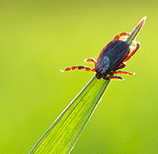Overview
Lyme disease is caused by a spiral-shaped microscopic organism, or spirochete, called Borrelia burgdorferi. This bacterium lives in the gut of the eastern black-legged tick, previously referred to as the deer tick (Ixodes scapularis) and the Western black-legged tick (Ixodes pacificus), and can be transmitted when an infected tick feeds on a dog, person, or other mammal. These ticks are extremely small, ranging from the size of a grain of sand to the size of a sesame seed. Black-legged ticks prefer to hide in shady, moist ground litter, but they can be found above ground, clinging to tall grass, brush, shrubs, and low tree branches. They also inhabit gardens and lawns, particularly at the edges of woodlands and around old stone walls, where deer and white-footed mice, the ticks' preferred hosts, thrive.
Lyme disease has been found in every state in the U.S. and some provinces in Canada, likely because pets and animals travel. It is especially regionally important where the tick vectors live, and this area is expanding rapidly.
- Northeast and mid-Atlantic, from northeastern Virginia to Maine
- North central states, mostly in Wisconsin and Minnesota
- West Coast, particularly northern California
Dogs are significantly more likely to be exposed to B. burgdorferi from the bite of an infected tick than are people, but are less likely to become sick with Lyme disease.1 2
Risk
Lyme can affect dogs of all ages, breeds, and sizes. The more time a dog spends outside in areas where ticks are prevalent, the greater the risk! In addition to Lyme disease, dogs are at risk for many other different tick-borne infections.
 There are several scary things about Lyme disease:
There are several scary things about Lyme disease:
- People can also be infected by the same ticks that infect our dogs. If your dog is a tick magnet, make sure you talk to your veterinarian about proper protection.
- Ticks are not always easy to spot, and it is almost impossible to identify a tick bite—especially if your dog has a thick coat.
- Symptoms of Lyme disease vary and can be difficult to detect, with warning signs that may not appear until several months after infection.
Signs
Lyme disease can affect different organs and systems within the body. The most common symptoms you might spot are:
- Recurrent painful joints that lasts 3–4 days, sometimes accompanied by loss of appetite and depression
- Reluctance to move, or a stiff, painful gait
- Swollen joints that are warm to the touch
- Leg pain or pain throughout the body
- Fever, fatigue, and swollen lymph nodes
Symptoms of Lyme disease may come and go, vary from mild to severe, and mimic other conditions. In many dogs, the signs may not appear for several months after infection. In severe cases, dogs may also develop heart disease, central nervous system disorders, or often-fatal kidney disease.
Diagnosis/Treatment
So let’s talk about the good news. Tests are now available to accurately diagnose your dog for Lyme and other tick-borne infections. If your veterinarian suspects your pooch may have Lyme disease, they will take a thorough history of your dog’s symptoms and activities and recommend testing your dog for Lyme disease, as well as other common tick-borne infections. In some cases, dogs can be coinfected with more than one type of tick-borne organism causing canine ehrlichiosis, canine anaplasmosis, and Rocky Mountain spotted fever.
Your veterinarian may recommend additional tests based on your dog's symptoms.
These could include:

- Chemistry tests to evaluate kidney, liver, and pancreatic function, as well as sugar levels
- Blood parasite screening to identify if your pet has been exposed to tick-borne or other infections
- Quantitative Lyme antibody levels to monitor response to treatment
- Fecal tests to rule out intestinal parasites
- A complete blood count (CBC) to assess for blood-related conditions
- Electrolyte tests to ensure your pet isn’t dehydrated or suffering from an electrolyte imbalance
- Urine tests to screen for urinary tract infections or other disease, look for protein, and to evaluate the kidney’s ability to concentrate urine
- A thyroid test to determine if the thyroid gland is producing too little thyroid hormone
- An ECG to screen for an abnormal heart rhythm, which may indicate underlying heart problems
Successful treatment of Lyme disease is dependent upon early detection and the severity of your dog’s symptoms. Antibiotic therapy with doxycyline is most commonly prescribed, although your veterinarian may prescribe a different antibiotic and other treatments depending on your dog’s clinical signs and circumstances. In general, most dogs respond quickly with appropriate treatment, and symptoms improve in as little as 24–48 hours. Follow-up testing to ensure adequate response to treatment is recommended.
Prevention
There are several steps you can take to prevent your dog from getting Lyme or other tick-borne diseases:
- Talk to your veterinarian about tick-borne diseases in your area.
- Use a veterinarian-recommended tick preventive on your dog.
- Talk to your veterinarian about vaccinating your dog against Lyme disease.
- Ask your veterinarian to conduct a tick screening at each exam.
- Watch your dog closely for changes in behavior or appetite.
- Check for ticks daily.
If you find a tick on your dog, remove it right away to limit infection. Here are some tips for safe and effective tick removal:
- Wear rubber gloves to protect your hands.
- Grasp the tick very close to the skin with a pair of fine-tipped tweezers. With a steady motion, pull the tick's body away from the skin. To prevent infection, avoid crushing the tick. After tick removal, clean your dog's skin with soap and warm water.
- Speak with your veterinarian about opportunities to test the tick before disposal.
- The tick may be saved in a sealable plastic bag in the freezer
- If choosing disposal, throw the dead tick away with your household trash or flush it down the toilet.
- Never use petroleum jelly, a hot match, nail polish or other products to remove a tick.
If you have any questions or concerns, you should always visit or call your veterinarian – they are your best resource to ensure the health and well-being of your pets.
References:
2) https://www.capcvet.org/guidelines/lyme-disease/
Beware the Bug More about Lyme Protecting Your Dog From Lyme Disease Can Lyme Disease in Dogs Spread to People? 10 Things You Might Not Know About Lyme Disease Or learn more about dogs and parasites > |

